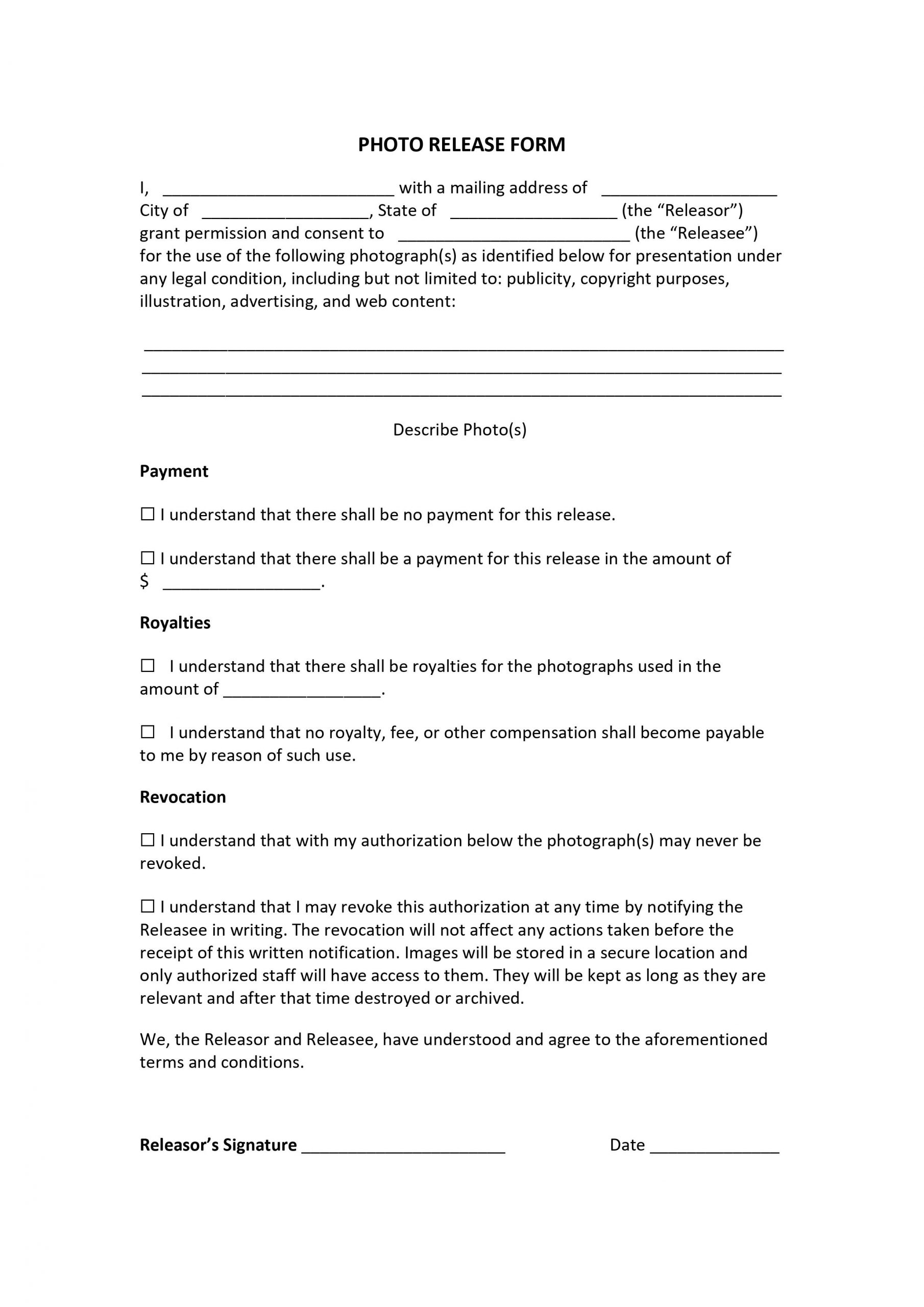- Eviction Notice Forms
- Power of Attorney Forms Forms
- Bill of Sale (Purchase Agreement) Forms
- Lease Agreement Forms
- Rental Application Forms
- Living Will Forms Forms
- Recommendation Letters Forms
- Resignation Letters Forms
- Release of Liability Agreement Forms
- Promissory Note Forms
- LLC Operating Agreement Forms
- Deed of Sale Forms
- Consent Form Forms
- Support Affidavit Forms
- Paternity Affidavit Forms
- Marital Affidavit Forms
- Financial Affidavit Forms
- Residential Affidavit Forms
- Affidavit of Identity Forms
- Affidavit of Title Forms
- Employment Affidavit Forms
- Affidavit of Loss Forms
- Gift Affidavit Forms
- Small Estate Affidavit Forms
- Service Affidavit Forms
- Heirship Affidavit Forms
- Survivorship Affidavit Forms
- Desistance Affidavit Forms
- Discrepancy Affidavit Forms
- Guardianship Affidavit Forms
- Undertaking Affidavit Forms
- General Affidavit Forms
- Affidavit of Death Forms
Photo Release Form
Great pictures sell products. Although every business has different needs for professional photography, photos still can positively contribute to visual marketing, SEO, personal branding, and business growth. Because of that, photographers need to obtain consent if a business uses their work to gain profit. Thus, the need for a photo release form. Find out more about a photo release form and how a great picture affects businesses in this article. Continue reading below. Read More Read More
What Is a Photo Release Form?
A photo release form allows an individual to use photographs for personal or commercial use. However, using the releasor’s work may come with terms and conditions. Often, the releasing party can choose to give away the rights for free or charge a royalty for the images. The ownership of the images does not become final until the payment has been made. And, the release form has been notarized.
How Do You Craft a Photo Release Form In Four Easy Steps?
Photography is one of the most useful hobbies you can have. Why? It helps cultivate your inner creativity and engage meaningfully with your surrounding. Since photography is not an activity reserved for professionals anymore, anyone can take great pictures. But, the easy access to photography sometimes disregards the rights of ownership. That is why a photo release form is essential when photos are used for profit. . Here are steps to help you craft a photo release form in MS Word and PDF file formats. More on this below:
1. Supply the Basic Information
A photo release form begins with the basic details of the parties. As two parties are participating in the arrangement, provide the following: Releasor’s name, street, city, state, releasee’s name, and photo descriptions. Providing these details is beneficial to the arrangement. It introduces the parties as well as sets out their involvement. Make sure the information is factual and can be supported with other legal documents. If not, the parties will be in so much trouble.
2. Set Out the Terms for Payment/Royalties
When it comes to a photo release arrangement, setting the payment terms is crucial. The releasor must indicate whether to give the rights to the images for free or not. Thus, provide options to let the parties either include fees or release the images without involving money. If there will be payment, indicate the amount. Similarly, the release form must stipulate the option for a royalties arrangement. The releasor can do this by dedicating another section to royalties terms.
3. Indicate Whether the Rights Is Revocable or Not
Another important part of a photo release form is the rights to the images. Primarily, the releasor owns the pictures. If he or she consents an individual to use their work, the release form must provide provisions to that. The form must indicate whether the releasor will be able to revoke the rights to the photos once released or not. Although there are legal protections that can help withdraw release arrangements, settling this in the release form firsthand can prevent further disputes.
4. Sign the Photo Release Form
The release form ends after stating the rights to the picture’s ownership agreed by the releasor and releasee. Then, both parties must sign the photo release form to seal the deal. On the other hand, if your state needs you to notarize the document, make sure to meet with a notary public. Some states require a witness or two upon signing the form. To check the form’s legitimacy, consult with a lawyer. It is an opportunity to ask questions and settle concerns, too.
Frequently Asked Questions
What is a photo consent form?
A photo consent form is a document allowing someone to use a photo of another person. Unlike a photo release form that consents another party of using any picture the releasor owned, a photo consent form permits the releasee to use the releasor’s picture of themselves in publications, such as social media, television, Youtube, etc.
Do you need permission to use someone’s photo?
There is no legal requirement that authorizes an individual in using someone else’s picture. But, in cases where photography infringes important social interests like social security, children protection, privacy rights, etc., permission to use someone’s photo is required.
How can I legally use copyrighted photos?
It is not impossible to use copyrighted images. You just need to get a license or permission to use the pictures from its rightful owner. Some third-party websites may help to license the images or talk with the picture’s creator directly.
Making a photo release form is easier than facing disputes over rights to picture ownership. If you are attempting to make a profit by using a picture you do not own, secure a photo release form first. It will protect you and the other party from infringing personal interests.

